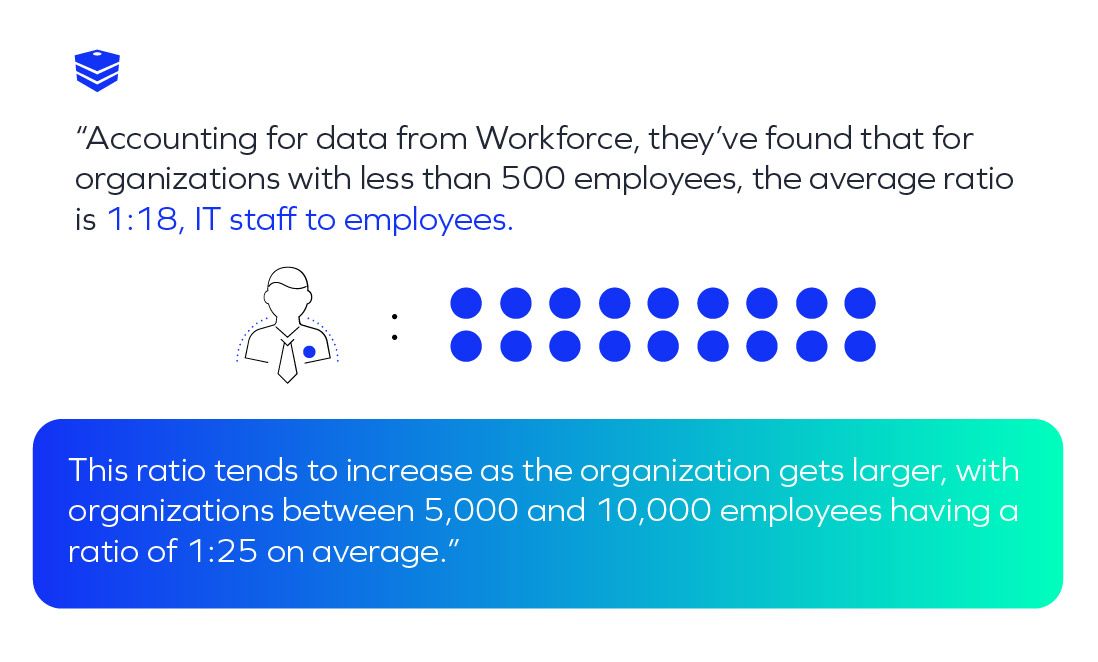Cybersecurity Consulting
IT Staffing Ratios: How Big Should Your Team Be?
June 06, 2024
5 Minutes

To protect against current cyber threats, organizations must have a strong cybersecurity posture. However, you can’t build a robust cybersecurity strategy without first establishing a healthy network—which requires well-trained IT experts.
But how many? Achieving the proper IT staff ratio is critical in successfully implementing modern cybersecurity strategies.
Sign up for our newsletter!
The golden IT staffing ratio is essentially the number of cybersecurity and IT professionals that should be employed based on the size and needs of an organization. While there are a few general rules of thumb when it comes to calculating this, it can tend to be fairly unique to each organization.
Keeping pace with the rapid cybersecurity landscape demands a certain amount of dedicated time and attention, which is why the size of your IT and cybersecurity teams is so crucial.
Modern cybersecurity strategies make use of multiple defense mechanisms that work in concert to keep your network, your data, and, your people safe. Check out DOT Security’s infographic, The Layered Cybersecurity Defense, for a deeper dive into various cybersecurity protocols and tools.
The State of Cybersecurity Staffing
In recent years, cybersecurity has become a top priority for businesses across industries as the number and severity of cyber threats continue to rise. However, the demand for skilled cybersecurity professionals has far outpaced the supply, leading to a shortage of talent in the industry.
The global cybersecurity workforce shortage is currently at 3.4 million professionals. This shortage has led to significant challenges for businesses trying to build and maintain strong cybersecurity teams. Many organizations struggle to find qualified candidates and those that do often face stiff competition from other companies, making retaining talent difficult and expensive.
A shortage of workers also means the ones that do exist are left with a larger workload, causing high levels of burnout and stress.
Understanding IT Staffing Ratios for Cybersecurity
IT staffing ratios are a key consideration when it comes to building a strong cybersecurity team. This ratio refers to the number of IT and cybersecurity professionals that should be employed based on the needs of your business.
There is no one-size-fits-all approach to IT staffing ratios for cybersecurity, but there are some typical ratios that organizations can use as a starting point.
According to data from Workforce, an organization with under 500 employees would want an IT professional for every 18 employees (a ratio of 1:18). As organizations grow, however, this ratio changes. Organizations that employ between 1,000 to 5,000 people, for instance, would want this ratio to be closer to 1:23.

Ultimately, maintaining a proper IT staffing ratio will improve your average network health, ensure that technology functions how it’s supposed to, and provide enough bandwidth to address support tickets as they emerge.
While the workforce data gives us a nice starting point, it’s also worth noting that IT and cybersecurity staffing ratios can vary widely depending on factors like:
- **Industry—**Finance and healthcare businesses need to stay compliant with more stringent regulations than other companies, which means more security controls and more work.
- **Risk Level—**The amount of sensitive information you have, the size of your business, the way you store data, your industry, your location, and more can all affect how high the risk level is for your business. The higher the risk, the more security you need.
- **Sensitivity of Data—**No matter the industry, if you’re collecting sensitive information (credit card info, personal information like addresses or phone numbers, or any purchasing history), your business could be a bigger target and require more security teams.
- **Attack History—**Organizations with a history of frequent attacks may need a larger cybersecurity team to stay protected.
- **Complexity of Infrastructure—**If your business deals with more complicated technologies, you could need more complex security controls to protect them.
The goal of establishing an appropriate IT and cybersecurity staffing ratio is to ensure that the organization has the necessary resources to maintain the health of the network and to identify, prevent, and respond to cyber threats effectively. By doing so, organizations can better protect their data, customers, and staff, all-in-all, effectively mitigating the risk of costly cyberattacks.
Finding the Right Staffing Ratio for Your Organization
Determining the right IT staffing ratio for cybersecurity requires a comprehensive assessment of an organization's needs. This assessment typically looks something like this:
1. Conduct a Risk Assessment: A risk assessment is an expert-led examination of your business’ network, devices, and general organizational security awareness to determine weaknesses, strengths, and overall risks of cyberattacks. It can help organizations understand the potential threats and vulnerabilities they face and the impact these threats could have on their business. This can help guide decisions about the appropriate level of cybersecurity staffing needed to mitigate those risks.
2. Evaluate Current Staffing Levels: Organizations should assess whether they have enough resources to address existing threats and vulnerabilities. This evaluation should take into account the size of the organization, the complexity of its technological infrastructure, and the level of risk faced by the business.
3. Identify Staffing Gaps: After evaluating current staffing levels, organizations should identify any gaps in their cybersecurity expertise. This can help guide decisions about the type of professionals that need to be hired or the level of training and development required to build up existing staff.
4. Continuously Monitor and Adjust Staffing Levels: Cybersecurity threats and risks are constantly evolving, and organizations must be prepared to adjust their staffing levels accordingly. Regularly monitoring and assessing staffing needs can help ensure that an organization has the necessary resources to address current and future threats.
5. Consider Outsourcing Options: Outsourcing some or all of an organization's cybersecurity needs can be a cost-effective solution for addressing staffing gaps. A managed security services provider (MSSP) has a complete team of experts and the technology needed to execute security strategies.
By following these steps, organizations can gain a better understanding of their cybersecurity staffing needs and make informed decisions about the appropriate IT staffing ratios.
Cybersecurity Options for Businesses Without a Large IT Staff
For many businesses, building a full-fledged cybersecurity team may not be feasible due to budget constraints or the staffing shortage. However, that doesn't mean those businesses can't effectively manage cybersecurity risks. Working with an MSSP can be a cost-effective way to address cybersecurity staffing gaps.
MSSPs offer a range of security services, such as network security, endpoint protection, and security monitoring, that can be customized to meet an organization's specific needs.
By partnering with an MSSP, businesses can access a team of highly trained cybersecurity experts who can provide monitoring and responses to potential security incidents. This can be especially valuable for companies with limited resources or those that operate outside of traditional business hours.
In addition, an MSSP can provide access to advanced security technologies and tools that may be too expensive for a business to purchase and maintain on its own. MSSPs can leverage economies of scale to provide enterprise-level security solutions to organizations of all sizes.
Working with an MSSP can be an effective way for businesses to address cybersecurity needs without the expenses of building large internal security teams. By outsourcing security needs to an experienced and qualified provider, organizations can gain peace of mind and focus on their core operations while leaving cybersecurity to the experts.
The Final Count: Wrapping Up on IT Staffing Ratios
All-in-all, the size of your IT and cybersecurity team is going to depend on a variety of factors. One such factor is the size of your business as a whole, but this isn’t the only consideration that goes into staffing decisions. As such, keep the following in mind when building out your own IT and cybersecurity teams:
- IT staffing ratios are an important consideration for building a strong cybersecurity team because bigger businesses with more risk need more security personnel. Determining the appropriate staffing ratio requires a comprehensive assessment of an organization's needs.
- IT and cybersecurity staffing ratios can vary widely based on the size and needs of an organization.
- There is currently a significant shortage of cybersecurity professionals worldwide making it hard for organizations to find and retain qualified talent.
- Conducting a risk assessment can help guide decisions about the appropriate level of cybersecurity staffing needed. Part of this is evaluating current staffing levels, which can help identify any gaps in cybersecurity expertise.
- Outsourcing some or all of an organization's cybersecurity needs can be a cost-effective solution for addressing staffing gaps.
Building a strong cybersecurity team requires careful consideration of an organization's unique needs and risks. By assessing staffing needs, identifying gaps, and continuously monitoring and adjusting staffing levels, organizations can better protect themselves against cyber threats and mitigate the risk of costly cyberattacks.
However, businesses that lack the resources to acquire appropriately sized security teams should look for external sources, like MSSPs, to get the expertise and controls they need.
When it comes to cybersecurity, you don’t want to build a house of cards. You don’t want your entire defense strategy to come toppling down due to a single point of failure. Take a look at DOT Security’s infographic, The Layered Cybersecurity Defense to learn more about building a strong cybersecurity strategy.
